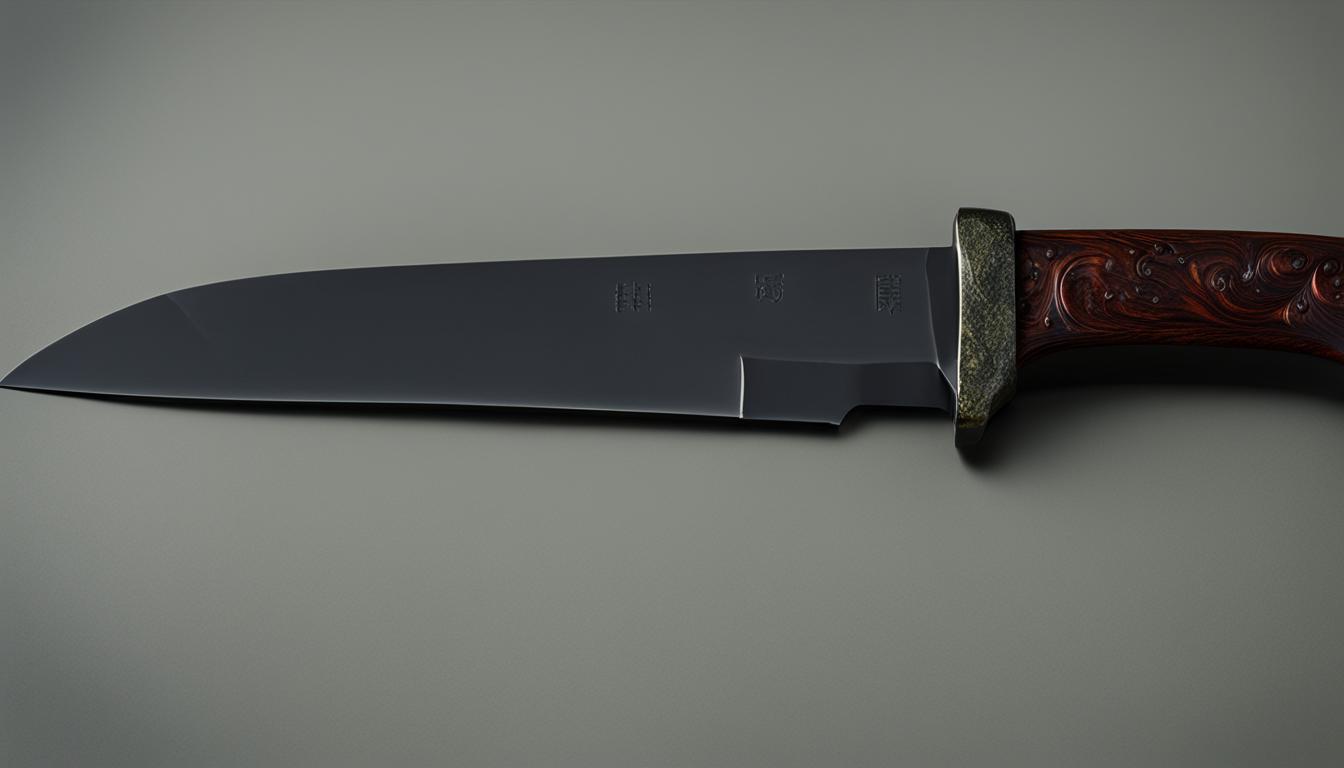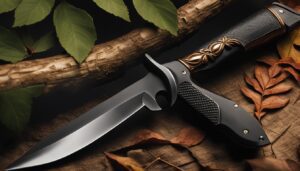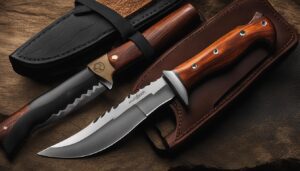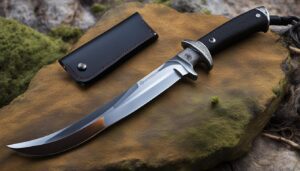As a hunter, having the right tools is crucial for the success of your expedition. One essential tool that every hunter should have is a hunting knife. A hunting knife serves various purposes, from gutting and skinning to field dressing and butchering game. With so many options available in the market, it’s important to choose the right hunting knife that suits your needs.
Before we delve into the details, let’s explore the different types of hunting knives, their features, and how they have evolved over time. We’ll also discuss the importance of considering factors like blade design, blade material, handle material, and intended use when selecting a hunting knife.
Key Takeaways:
- Choosing the right hunting knife is crucial for every hunter.
- Hunting knives serve multiple purposes, including gutting, skinning, and field dressing.
- Consider factors like blade design, blade material, handle material, and intended use when selecting a hunting knife.
- There are various types of hunting knives available, each with its own unique features and uses.
- Optional features like gut hooks and different blade styles add versatility to hunting knives.
History of the Hunting Knife
The history of the hunting knife can be traced back to the Stone Age, when early humans used primitive blades made from stone, shell, or bone for hunting and survival. These early hunting knives served as essential tools for cutting, slicing, and butchering game.
However, it was in the 19th century that hunting knives truly began to evolve. One notable figure in the history of hunting knives is Jim Bowie, who famously modified and personalized his blades to suit his specific needs. This gave rise to the iconic Bowie knife, known for its distinctive shape and rugged durability.
Another significant milestone in the history of hunting knives was the introduction of the Swiss Army knife, which revolutionized the world of folding knives. Although primarily designed for soldiers, the versatility and compactness of the Swiss Army knife made it a popular choice among hunters as well.
The mid-20th century saw the birth of the drop point hunter, a knife design pioneered by R.W. Loveless. The drop point blade, with its curved shape and strong tip, became a favorite among hunters for its versatility and ability to handle various tasks in the field.
Uses of Hunting Knives
Hunting knives are versatile tools that serve various purposes in the field. They are essential for hunters when it comes to gutting, skinning, deboning, butchering, caping, and hunting. Let’s explore these different uses in detail:
Gutting
Gutting is a crucial step in field dressing game animals. It involves removing the internal organs to prepare the animal for further processing. Hunting knives with a strong and sharp blade are designed specifically for this task. With a gutting knife, hunters can efficiently and cleanly remove the organs, ensuring the quality of the meat and minimizing the risk of contamination.
Skinning
After gutting, the next step is skinning the animal. Skinning knives are designed with a curved and narrow blade to make precise cuts through the animal’s skin without damaging the meat underneath. This ensures the preservation of the hide for trophy preparation or other purposes. Skinning knives are also useful in removing the hide from smaller game animals, such as rabbits or squirrels.
Deboning and Butchering
Once the animal is gutted and skinned, the meat needs to be deboned and butchered into usable portions. Deboning knives are specifically designed to separate the meat from the bones, allowing hunters to efficiently remove every bit of valuable meat. Butcher knives, on the other hand, are used for cutting up the meat into different cuts, such as steaks or roasts, according to the hunter’s preference.
Caping
Caping is a specialized process for preparing the head and neck of an animal as a hunting trophy. Caping knives have a fine and delicate blade that allows hunters to make precise cuts around the head and neck, preserving the hide and ensuring a beautiful trophy mount. Caping requires skill and precision, and having the right knife is essential for a successful outcome.
Hunting
Of course, hunting knives are also used for the primary purpose of hunting itself. These knives are designed for killing, mainly in practices like hog hunting. They have sturdy blades and ergonomic handles that provide hunters with the necessary tools to take down game efficiently and safely. Hunting knives come in various styles and designs, catering to different types of hunting and personal preferences.
As we can see, hunting knives are versatile tools that serve multiple functions in the field. Whether it’s gutting, skinning, deboning, butchering, caping, or hunting itself, having the right knife for the job is essential for a successful hunting experience.

Types of Hunting Knives
When it comes to choosing a hunting knife, there are various types available that cater to different needs and preferences. Each type has its own unique features and benefits, making it important to understand the options before making a decision.
Camp Knife
The camp knife is a versatile tool that is ideal for various tasks in the field. It typically has a sturdy, fixed blade with a pointy tip and a comfortable handle. The camp knife is designed to handle tasks such as preparing meals, cutting ropes, and even light chopping. It is a popular choice among hunters who need a reliable all-around tool.
Bowie Knife
The Bowie knife is a classic and iconic hunting knife that was popularized by Jim Bowie in the 19th century. It features a large, clip-point blade with a sharp edge and a curved spine. The Bowie knife is known for its strength and versatility, making it suitable for a wide range of hunting tasks. Whether you need to skin an animal or perform heavy-duty cutting, the Bowie knife is up to the task.
Caping Knife
A caping knife is specifically designed for delicate tasks such as preparing a trophy mount. It has a small, curved blade with an upturned point, allowing for precise and controlled cuts while preserving the hide. The caping knife is essential for hunters who want to create a high-quality trophy mount without damaging the animal’s hide.
Skinning Knife
The skinning knife is specifically designed for the skinning process, where the hide of the animal is removed. It typically has a thin, narrow blade with a curved edge, allowing for easy and efficient skinning without damaging the meat. The skinning knife is a must-have for hunters who want to efficiently process their game in the field.
Boning Knife
A boning knife is designed for removing meat from the bone. It has a narrow, flexible blade that allows for precise cuts and easy maneuverability around joints and bones. The boning knife is perfect for hunters who want to efficiently separate meat from the bone, whether it’s for cooking or further processing.
Buck Knife
Originally designed for hunters, the buck knife has become a popular choice for everyday carry due to its versatility and reliability. It typically features a folding blade that can be easily stored in a pocket or a sheath. The buck knife can handle a variety of tasks, making it a practical and convenient option for hunters and outdoor enthusiasts.
Hunting Knife Set
If you’re looking for a complete hunting toolset, a hunting knife set is a great option. These sets typically include a combination of different knives and tools such as a gut hook, skinner, boner, and caping knife. A hunting knife set provides hunters with a comprehensive solution for various field dressing and processing needs, ensuring they have the right tool for every task.
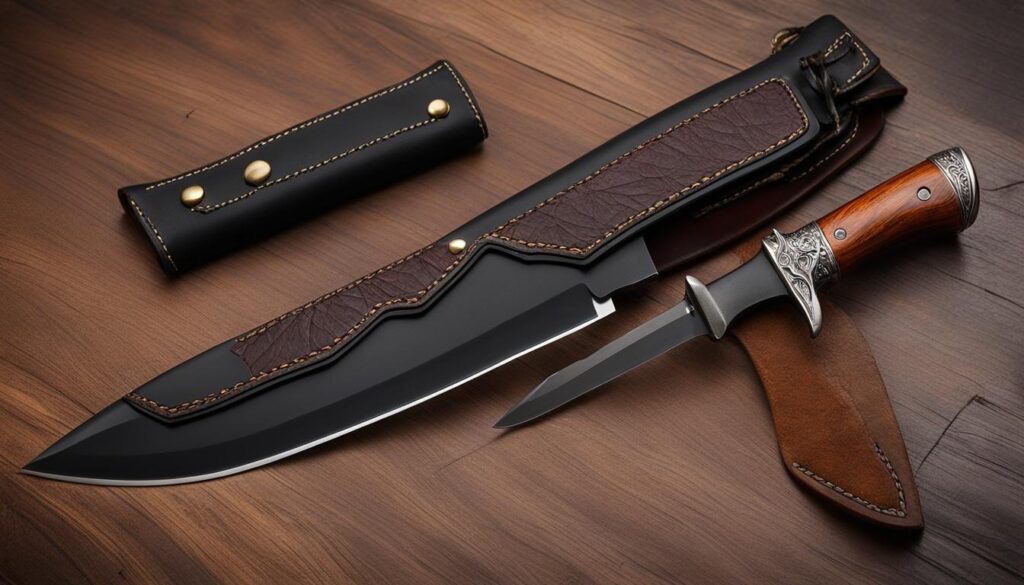

Optional Features of Hunting Knives
Hunting knives come with various optional features that can enhance their functionality and performance in the field. One popular feature is the gut hook, which is a sharpened semi-circle ground into the spine of the blade. The gut hook allows hunters to easily unzip an animal’s skin during field dressing, making the gutting process more efficient and precise. Whether you’re dressing a deer or preparing a hog for butchering, a hunting knife with a gut hook can be a valuable tool.
Another important consideration when choosing a hunting knife is the blade style. There are different blade styles available, each with its own advantages and uses. The clip point blade, derived from the Bowie knife, has a clipped-off portion near the tip, making it ideal for puncturing and detail work. The drop point blade, on the other hand, has a curved and strong design, making it versatile for various tasks such as skinning and butchering. Skinning blades are highly sweeping and designed for effortless flesh and skin separation, making them perfect for skinning game animals.
Having a hunting knife with the right optional features can significantly improve your hunting experience and make field dressing and butchering more efficient. Whether you prefer a knife with a gut hook for easy skinning or a specific blade style to suit your hunting needs, understanding these features can help you make an informed decision when choosing a hunting knife.
| Optional Feature | Description |
|---|---|
| Gut Hook | A sharpened semi-circle ground into the spine of the blade, used for easily unzipping an animal’s skin during field dressing. |
| Blade Style | Different blade styles such as clip point, drop point, and skinning blades offer versatility and suitability for specific tasks. |
What to Consider When Choosing a Hunting Knife
When selecting a hunting knife, there are several crucial factors to consider that will ensure you make the right choice. These factors include the handle shape, blade shape, fixed or folding blades, blade flexibility, and handle materials. By carefully considering these elements, you can find a hunting knife that meets your specific needs and enhances your hunting experience.
Handle Shape
The handle shape of a hunting knife is an important consideration as it directly affects comfort and grip. Look for a handle with the right length and features such as finger stops or grooves to prevent hand slippage. It’s essential to choose a handle shape that feels secure in your hand, providing you with stability and control during use.
Blade Shape
Another crucial factor to consider is the blade shape. The blade shape should align with the intended use of the knife, whether it’s skinning, filleting, or gutting. Different blade shapes offer various advantages and disadvantages, so it’s worth researching and understanding which shape is best suited for your specific hunting needs.
Fixed or Folding Blades
Deciding between a fixed or folding blade is a critical consideration. Fixed blades are typically more durable and easier to clean, making them a popular choice among hunters. However, folding blades offer the advantage of compactness and safety, as they can be easily folded and stored when not in use. Consider your personal preferences and the specific demands of your hunting activities when deciding between a fixed or folding blade design.
Blade Flexibility
The flexibility of the blade is another factor to consider. Some knives have rigid blades that provide precise control, while others have more flexibility, allowing for easier maneuverability around joints and bones. Depending on the type of game and tasks you’ll be performing, you’ll want to choose a blade with the appropriate level of flexibility to ensure efficient and effective performance in the field.
Handle Materials
The choice of handle material is also an important consideration. Handle materials can range from wood and metal to synthetic materials like plastics, carbon fiber, and resin. Each material offers different advantages in terms of durability, comfort, and grip. Consider your personal preferences and the specific demands of your hunting activities when selecting the handle material that best suits your needs.
By considering factors such as handle shape, blade shape, fixed or folding blades, blade flexibility, and handle materials, you can confidently choose a hunting knife that will serve you well in the field. Take the time to research and understand the options available, and make an informed decision based on your specific hunting needs. Remember, the right hunting knife can make a significant difference in your hunting experience, providing you with the reliability and functionality you require.
Knife Blade Design and Materials
When it comes to hunting knives, the design and materials of the blade play a crucial role in their functionality and performance. The blade design determines the knife’s versatility and effectiveness for specific tasks, while the choice of blade material affects its durability, sharpness retention, and resistance to rust and wear. Understanding these factors is essential for selecting the right hunting knife for your needs.
Blade Design
There are several blade designs commonly used in hunting knives:
- Drop Point: This design features a strong, curved blade that is ideal for skinning game and performing heavy-duty cutting tasks.
- Clip Point: The clip point blade has a more tapered and sharper tip, making it versatile for detailed work but less efficient for skinning.
- Skinning Blade: Skinning blades are specifically designed with a highly sweeping curve, allowing for effortless separation of flesh and skin.
The choice of blade design depends on the intended use of the knife. If you primarily engage in skinning and heavy cutting tasks, a drop point blade will be a reliable option. For more versatile applications, a clip point blade could be suitable. Skinning blades are best if your main focus is on efficiently removing the hide from game.
Blade Materials
The materials used in the construction of hunting knife blades can greatly impact their performance and durability. Here are some commonly used blade materials:
| Blade Material | Characteristics |
|---|---|
| S30V | Offers excellent edge retention and corrosion resistance, making it ideal for prolonged use in various weather conditions. |
| 154CM | Known for its toughness and ability to hold an edge, making it suitable for heavy-duty cutting tasks. |
| VG-10 | Provides impressive sharpness and corrosion resistance, making it a popular choice for hunting knives. |
| 420HC | Offers good overall durability and ease of sharpening, making it a budget-friendly option for hunting knives. |
Each blade material has its unique characteristics, and the choice depends on your specific needs and preferences. Consider factors such as edge retention, corrosion resistance, and ease of sharpening when selecting the blade material for your hunting knife.
The design and materials of a hunting knife blade are crucial considerations that directly impact its performance, versatility, and durability. Understanding the different blade designs and materials available allows you to make an informed decision when choosing the right hunting knife for your needs. Whether you prioritize skinning, heavy-duty cutting, or overall versatility, selecting the appropriate blade design and material ensures a reliable and effective tool by your side in the field.
Conclusion
In conclusion, this comprehensive hunting knife guide provides valuable insights into choosing the perfect hunting knife for your specific needs. By considering factors such as intended use, blade shape, handle shape, blade flexibility, and handle materials, you can make an informed decision.
Understanding the history and types of hunting knives allows you to appreciate their evolution and practical applications. Whether you’re a seasoned hunter or just starting out, having the right hunting knife is essential.
Remember to take into account optional features like gut hooks and different blade styles, as they can add versatility to your hunting knife. Additionally, the blade design and material, as well as the handle material, play important roles in the knife’s overall performance and durability.
With the knowledge gained from this guide, you can confidently select the ideal hunting knife to accompany you on your hunting adventures. Happy hunting!
FAQ
What are the different types of hunting knives?
There are various types of hunting knives, including the camp knife, Bowie knife, caping knife, skinning knife, boning knife, buck knife, hunting knife, and hunting set.
What is the purpose of a gut hook on a hunting knife?
A gut hook is a sharpened semi-circle ground into the spine of the blade, allowing hunters to easily unzip an animal’s skin during field dressing.
What are the different blade styles of hunting knives?
Hunting knives can have different blade styles, including clip point, drop point, and skinning blades. Clip point blades are versatile, drop point blades are ideal for heavy-duty work, and skinning blades are specifically designed for effortless skinning.
What factors should I consider when choosing a hunting knife?
When choosing a hunting knife, factors to consider include intended use, size, fixed or folding blade, blade design, blade material, and handle material.
What are the common uses of hunting knives?
Hunting knives serve multiple purposes, such as gutting, skinning, boning, butchering, caping, and certain hunting practices like hog hunting.
What is the history of hunting knives?
Hunting knives have a long history, dating back to the Stone Age when early humans fashioned blades from stone, shell, or bone for hunting purposes. Notable advancements include the Bowie knife popularized by Jim Bowie and the Swiss Army knife, which popularized folding knives for hunters.
What are some optional features of hunting knives?
Optional features of hunting knives include gut hooks, which aid in field dressing, and different blade styles like clip point, drop point, and skinning blades.
What are the considerations for the handle of a hunting knife?
When considering the handle of a hunting knife, factors such as shape, length, and materials like wood, metal, synthetic materials, carbon fiber, and resin should be taken into account for comfort and grip.
What are the factors to consider for the blade of a hunting knife?
Factors to consider for the blade of a hunting knife include shape, flexibility, and materials like S30V, 154CM, VG-10, and 420HC, which offer different combinations of toughness, edge retention, rust resistance, and wear resistance.
